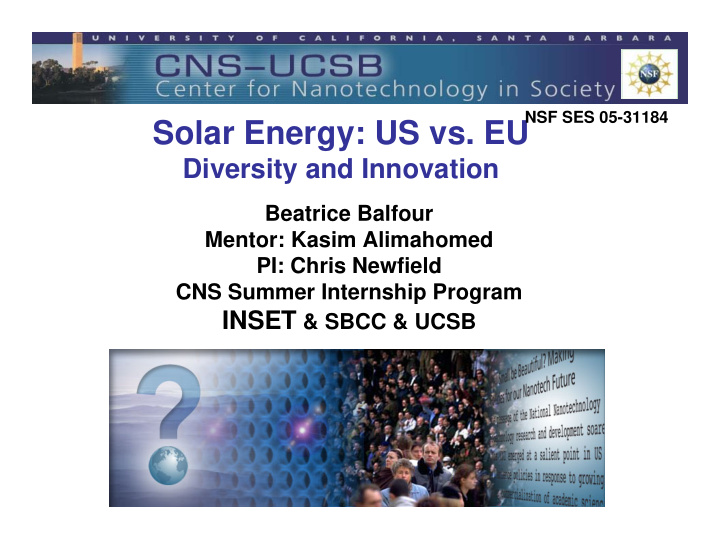



NSF SES 05-31184 Solar Energy: US vs. EU Diversity and Innovation Beatrice Balfour Mentor: Kasim Alimahomed PI: Chris Newfield CNS Summer Internship Program INSET & SBCC & UCSB
“Energy is the single most important challenge facing humanity today.” (Nobel Laureate Rick Smalley) 1 Global Picture • Global need for renewable energy. Solar energy has great potential (1 hr. = 14 TW.) 1 • • Different generations of solar: a. traditional PV c. thin films (Nano-solar)
“To change the world is not enough…Our job is to interpret it. This is so that the world does not continue to change without us. And, eventually, does not change in a world without us” (G. Anders) Innovation Pathways Production of PV, 2006 1000 • Global value chain 800 • Statistics 600 • US vs. EU 400 MW 200 0 United Europe States
Global Value Chain • Study of where the value is added • “Story” of product from creation to use/beyond • Main components of global value chain : - Supply Chain - Supporting Environment
Solar Global Value Chain The research process • Production process • Decide where to start from: • Company profile and partners • Supporting environment per country • Research further supporting material – World Intellectual Propriety Organization: Patents
Nano-solar Value Chain KONARKA Nano-Material Nano-intermidiates Nano-products Applications Portable Power Thin Film Ceramic Nanoparticles Solar Cells 1. Dye- sensitized 2. Organic 3. Hybrid Quantum Dots Evident Technologies : EviDots Out-door power Indoor Remote Sensing Solaris Nanoscience Nano-antenna Gold Nanoparticles Textronics: clothing with power Military Equipment Consumer Applications Kurz: Roll to Roll Printing Process
EU on International Scale
EU on National Scale
Final Picture “…so that the world does not continue to change without us. And, eventually, does not change in a world without us” (G. Anders)
Acknowledgements � Thank you for the great help to Kasim Alimahomed, Chris Newfield, Jerry Macala, Rachel Parcker, and Richard Appelbaum. � Thank you for the great help to Julie Dillemuth, Jens, and Dr. Nick Arnold. � Thank you for the collaboration to Sarah Bunch. � Special thanks to Nicole Biergiel. � Thank you to CNS, NSF, SBCC, UCSB, INSET, and everybody who gave me the opportunity to participate in this internship.
Works Cited (TO FINISH) 1) Nathan, Lewis S. "Powering the Planet." California Institute of Technology. 27 June 2008 <http://nsl.caltech.edu/energy.html>. 2) Frosch, Dan. "Citing Need for Assessments, U.S. Freezes Solar Energy Projects." The New York Times 27 June 2008. 27 June 2008 <http://www.nytimes.com/2008/06/27/us/27solar.html?_r=1&scp= 1&sq=solar&st=nyt&oref=slogin>. 3) "European Legislation." EPIA. European Photovoltaic Industry Association. 8 July 2008 <http://www.epia.org/index.php?id=5>. 4) "Conto Energia." Helios Technology. 8 July 2008 <http://www.heliostechnology.info/?pag=CONTO_ENERGIA>.
Recommend
More recommend